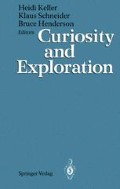Abstract
Humans interact with their environment in different behavioral modes such as seeing, hearing, smelling, touching, approaching, manipulating, and talking. These interactions create information and belong to the behavioral system of exploration. Although they share the common purpose of information input, they differ significantly in structure. Shulamith and Hans Kreitler (1987, see also this volume; and Kreitler, Zigler, & Kreitler, 1974, 1975) who have done extensive research on the factor structure of exploration have repeatedly identified five factors in children as well as in adults. The most powerful factors with respect to the amount of explained variance in 6-to 8-year-old children were manipulative exploration (17.5%, focused on exploring by means of motor actions), followed by perceptual exploration (12.5%, focused on exploring by means of viewing, listening, or smelling) and conceptual exploration (9.3%, focused on exploring by checking meanings and their interrelations and by asking questions).
Access this chapter
Tax calculation will be finalised at checkout
Purchases are for personal use only
Preview
Unable to display preview. Download preview PDF.
References
Ainsworth, M.D.S., Blehar, M.C., Waters, E. & Wall, S. (1978). Patterns of attachment. A psychological study of the strange situation. Hillsdale, N.J.: Erlbaum.
Arend, R., Gove, F.L. & Sroufe, L.A. (1979). Continuity of individual adaptation from infancy to kindergarten: A predictive study of ego-resiliency and curiosity in preschoolers. Child Development, 50, 950–959.
Berlyne, D.E. (1960). Conflict, arousal, and curiosity. New York: McGraw-Hill.
Bischof, N. (1990). Interconnections of exploration, attachment, and autonomy. Paper read at the Conference “Curiosity and exploration” in Osnabrueck, March 19 – 22.
Bischof, N. (1985). Das Rätsel Ödipus: Die biologischen Wurzeln des Urkonfliktes von Intimität und Autonomie. München: Piper.
Bischof, N. (1975). A systems approach toward the functional connections of at tachment and fear. Child Development, 46, 801–817.
Bowlby, J. (1969). Attachment and loss, Vol. I: Attachment. New York: Basic Books.
Boyle, G.J. (1989). Breath-depth or state-trait curiosity? A factor analysis of state-trait curiosity and state anxiety scales. Person. Individ. Diff., 10 (2), 175–183.
Camp, C.J., Dietrich, M.S., & Olson, K.R. (1985). Curiosity and uncertainty in young, middle aged, and older adults. Ecucational Gerontology, 11, 401–412.
Gubler, H. & Bischof, N. (1991 in press). A systems’ perspective on infant development. In M.E. Lamb & H. Keller (Eds.), Infant development: perspectives from German-speaking countries. Hillsdale, N.J.: Erlbaum.
Hazen, N.L. (1982). Spatial exploration and spatial knowledge: individual and developmental differences in very young children. Child Development, 53, 826–833.
Henderson, B.B. (1984a). Social support and exploration. Child Development, 55, 1246–1251.
Henderson, B.B. (1984b). Parents and exploration: The effect of context on individual differences in exploratory behavior. Child Development, 55, 1237–1245.
Henderson, B.B. & Moore, S.G. (1979). Measuring exploratory behavior in young children: A factor-analytic study. Developmental Psychology, 15, 113–119.
Keller, H. (1991 in press) The development cf exploratory behavior. In H. Keller & K. Schneider (Eds.), Curiosity and exploration. New York: Springer.
Keller, H. (1989). Kontinuität und Entwicklung. In H. Keller (Hrsg.), Handbuch der Kleinkindforschung (S. 163–180). Heidelberg: Springer.
Keller, H. & Boigs, R. (1991 in press). Distal and proximal exploration as behavioral styles. In H. Keller & K. Schneider (Eds.), Curiosity and exploration. New York: Springer.
Keller, H. & Boigs, R. (1989). Entwicklung des Explorations Verhaltens. In H. Keller (Hrsg.), Handbuch der Kleinkindforschung (S. 443–464). Heidelberg: Springer.
Keller, H. & Gauda, G. (1987). Eye contact in the first months of life and its developmental consequences. In H. Rauh & H.-Ch. Steinhausen (Eds.), Psychobiology and early development (pp. 129–143). Amsterdam, NL: Elsevier.
Keller, H. & Zach, U. (1991 in press). Developmental consequences of early eye-contact behavior. Acta Paedopsychiatrica.
Keller, H., Gauda, G., & Schölmerich, A. (1985). Die Entwicklung des Explorations-verhaltens. Osnabrück: Bericht für die Deutsche Forschungsgemeinschaft.
Keller, H., Gauda, G., Miranda, D., & Schölmerich, A. (1982). Entwicklung des Ex-plorationsverhaltens. Darmstadt: Bericht für die Deutsche Forschungsgemeinschaft.
Keller, H., Schölmerich, A., Miranda, D., & Gauda, G. (1987). Exploratory behavior development in the first four years. In D. Görlitz & J.F. Wohlwill (Esd.), Curiosity, imagination and play (pp. 127–150). Hillsdale, N.J.: Erlbaum.
Koch, M. (1959). Wesensunterschiede menschlicher und tierischer Entwicklung. In H. Thomae (Ed.) Entwicklungspsychologie, 2. ed. (pp. 585–602). Göttingen: Verlag für Psychologie/Hogrefe.
Kreitler, S. & Kreitler, H. (1987). The motivational and cognitive determinants of individual planning. Genetic, Social and General Psychology Monographs, 113, 81–107.
Kreitler, S. & Kreitler, H. (1986). Types of curiosity behaviors and their cognitive determinants. Archives of Psychology, 138, 233–251.
Kreitler, S., Zigler, E., & Kreitler, H. (1975). The nature of curiosity in children. Journal of School Psychology, 13, 185–200.
Kreitler, S., Zigler, E., & Kreitler, H. (1974). The complexity of complexity. Human Development, 17, 54–73.
Main, M. (1983). Exploration, play, and cognitive functioning related to infant-mother attachment. Infant Behavior and Development, 6, 167–174.
Schneider, K., Moch, M., Sandfort, R., Auerswald, M., & Walther-Weckmann, K. (1983). Exploring a novel object by preschool children: A sequential analysis of perceptual, manipulating and verbal exploration. International Journal of Behavioral Development, 6, 477–496.
Schölmerich, A. (1990). Der Erwerb neuer Information im Verlauf des Exploration-snprozesses: eine sequentielle Analyse von Handlungsketten. Inaugural-Dissertation, Universität Osnabrück: Fachbereich Psychologie.
Thomas, A. & Chess, S. (1977). Temperament and development. New York: Brunner/Mazel.
Voss, H.G. & Meyer, HJ. (1987). Entwicklung explorativen Verhaltens in der frühen Kindheit (2–4. Lebensjahr) und Genese des Neugiermotivs. Darmstadt: Bericht für die Stiftung Volkswagenwerk.
Editor information
Editors and Affiliations
Rights and permissions
Copyright information
© 1994 Springer-Verlag Berlin Heidelberg
About this chapter
Cite this chapter
Keller, H. (1994). A Developmental Analysis of Exploration Styles. In: Keller, H., Schneider, K., Henderson, B. (eds) Curiosity and Exploration. Springer, Berlin, Heidelberg. https://doi.org/10.1007/978-3-642-77132-3_11
Download citation
DOI: https://doi.org/10.1007/978-3-642-77132-3_11
Publisher Name: Springer, Berlin, Heidelberg
Print ISBN: 978-3-540-54867-6
Online ISBN: 978-3-642-77132-3
eBook Packages: Springer Book Archive

